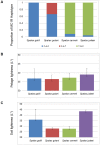Adaptation of pelage color and pigment variations in Israeli subterranean blind mole rats, Spalax ehrenbergi [corrected]
- PMID: 23935991
- PMCID: PMC3723903
- DOI: 10.1371/journal.pone.0069346
Adaptation of pelage color and pigment variations in Israeli subterranean blind mole rats, Spalax ehrenbergi [corrected]
Erratum in
- PLoS One. 2013;8(8). doi:10.1371/annotation/27bebc65-09c5-4c58-be6c-4f22c4fe0919
Abstract
Background: Concealing coloration in rodents is well established. However, only a few studies examined how soil color, pelage color, hair-melanin content, and genetics (i.e., the causal chain) synergize to configure it. This study investigates the causal chain of dorsal coloration in Israeli subterranean blind mole rats, Spalax ehrenbergi.
Methods: We examined pelage coloration of 128 adult animals from 11 populations belonging to four species of Spalax ehrenbergi superspecies (Spalax galili, Spalax golani, Spalax carmeli, and Spalax judaei) and the corresponding coloration of soil samples from the collection sites using a digital colorimeter. Additionally, we quantified hair-melanin contents of 67 animals using HPLC and sequenced the MC1R gene in 68 individuals from all four mole rat species.
Results: Due to high variability of soil colors, the correlation between soil and pelage color coordinates was weak and significant only between soil hue and pelage lightness. Multiple stepwise forward regression revealed that soil lightness was significantly associated with all pelage color variables. Pelage color lightness among the four species increased with the higher southward aridity in accordance to Gloger's rule (darker in humid habitats and lighter in arid habitats). Darker and lighter pelage colors are associated with darker basalt and terra rossa, and lighter rendzina soils, respectively. Despite soil lightness varying significantly, pelage lightness and eumelanin converged among populations living in similar soil types. Partial sequencing of the MC1R gene identified three allelic variants, two of which were predominant in northern species (S. galili and S. golani), and the third was exclusive to southern species (S. carmeli and S. judaei), which might have caused the differences found in pheomelanin/eumelanin ratio.
Conclusion/significance: Darker dorsal pelage in darker basalt and terra rossa soils in the north and lighter pelage in rendzina and loess soils in the south reflect the combined results of crypsis and thermoregulatory function following Gloger's rule.
Conflict of interest statement
Figures



References
-
- Burtt EH Jr (1981) The adaptiveness of colors. BioScience 31: 723–729.
-
- Cloudsley-Thompson JL (1999) Multiple factors in the evolution of animal coloration. Naturwissenschaften 86: 123–132. - PubMed
-
- Majerus MEN (1998) Melanism: evolution in action. Oxford: Oxford University Press. 364 p.
-
- Caro T (2005) The adaptive significances of animal colors. Bioscience 31, 723–729.
Publication types
MeSH terms
Substances
LinkOut - more resources
Full Text Sources
Other Literature Sources

